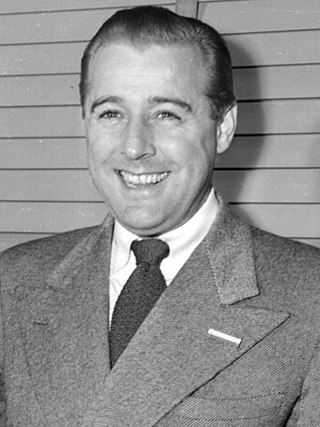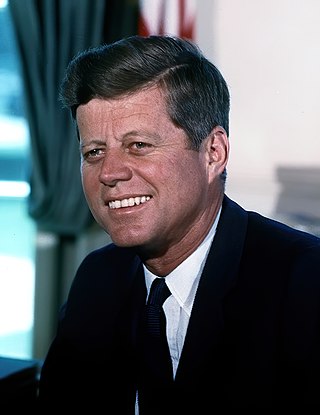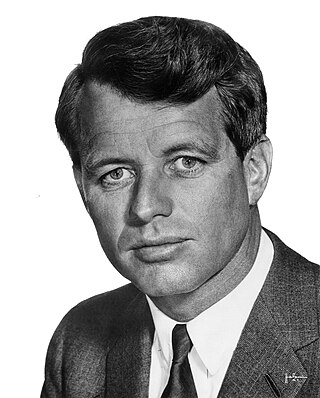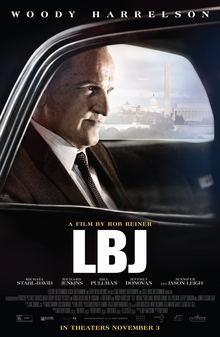
Lyndon Baines Johnson, often referred to by his initials LBJ, was an American politician who served as the 36th president of the United States from 1963 to 1969. He became president after the assassination of John F. Kennedy, under whom he had served as the 37th vice president from 1961 to 1963. A Democrat from Texas, Johnson also served as a U.S. representative and U.S. senator. Johnson is one of only three, along with Richard Nixon and Andrew Johnson, to have served in all four federally elected positions of the U.S. government.

The Great Society was a set of domestic programs in the United States launched by President Lyndon B. Johnson in 1964 and 1965. The term was first referenced during a 1964 speech by Johnson at Ohio University, then later formally presented at the University of Michigan, and came to represent his domestic agenda. The main goal was the total elimination of poverty and racial injustice.

Richard Brevard Russell Jr. was an American politician. A member of the Democratic Party, he served as the 66th Governor of Georgia from 1931 to 1933 before serving in the United States Senate for almost 40 years, from 1933 to 1971. Russell was a founder and leader of the conservative coalition that dominated Congress from 1937 to 1963, and at his death was the most senior member of the Senate. He was for decades a leader of Southern opposition to the civil rights movement.

Warren Grant Magnuson was an American lawyer and politician who represented the state of Washington in Congress for 44 years, first as a Representative from 1937 to 1944, and then as a senator from 1944 to 1981. Magnuson was a member of the Democratic Party. He was Washington state's longest-serving senator, serving over 36 years in the Senate. During his final two years in office, he was the most senior senator and president pro tempore.

John Fitzgerald Kennedy, often referred to by his initials JFK and by the nickname Jack, was an American politician who served as the 35th president of the United States from 1961 until his assassination in 1963. He was the youngest person elected president and the youngest president at the end of his tenure. Kennedy served at the height of the Cold War, and the majority of his foreign policy concerned relations with the Soviet Union and Cuba. A Democrat, Kennedy represented Massachusetts in both houses of the U.S. Congress prior to his presidency.

Lyndon B. Johnson's tenure as the 36th president of the United States began on November 22, 1963, following the assassination of President Kennedy and ended on January 20, 1969. He had been vice president for 1,036 days when he succeeded to the presidency. A Democrat from Texas, he ran for and won a full four-year term in the 1964 election, winning in a landslide over Republican opponent Arizona Senator Barry Goldwater. Johnson did not run for a second full term in the 1968 presidential election. He was succeeded by Republican Richard Nixon. His presidency marked the high tide of modern liberalism in the 20th century United States.

Robert Francis Kennedy, also known by his initials RFK and by the nickname Bobby, was an American politician and lawyer. He served as the 64th United States attorney general from January 1961 to September 1964, and as a U.S. senator from New York from January 1965 until his assassination in June 1968, when he was running for the Democratic presidential nomination. Like his brothers John F. Kennedy and Ted Kennedy, he was a prominent member of the Democratic Party and is an icon of modern American liberalism.

The Arms Control and Disarmament Act of 1961, 22 U.S.C. § 2551, was created to establish a governing body for the control and reduction of apocalyptic armaments with regards to protect a world from the burdens of armaments and the scourge of war.

LBJ is a 2016 American political drama film about the beginning of the administration of U.S. President Lyndon B. Johnson following the assassination of U.S. President John F. Kennedy. It was directed by Rob Reiner and written by Joey Hartstone, whose script was on the 2014 Black List. The film stars Woody Harrelson as the titular President, along with Richard Jenkins, Bill Pullman, Kim Allen, Michael Stahl-David, Jennifer Jason Leigh, Jeffrey Donovan, Doug McKeon, C. Thomas Howell, and Michael Mosley.
The presidency of Richard Nixon began on January 20, 1969, when Richard Nixon was inaugurated as the 37th president of the United States, and ended on August 9, 1974, when, in the face of almost certain impeachment and removal from office, he resigned the presidency.

The Declaration of Honolulu, 1966 was a communiqué and diplomatic proclamation acceded by foreign diplomats representing the Republic of Vietnam and the United States. The declaration asserted pro-democracy principles for South Vietnam while combating external aggression and insurgency by Democratic Republic of Vietnam. The goals outlined at the conference were a cornerstone to US policy in Vietnam until 1969 when the incoming Nixon administration changed policies towards Vietnam.
The following is a timeline of the presidency of Lyndon B. Johnson from January 1, 1967, to December 31, 1967.
The following is a timeline of the presidency of Bill Clinton, from January 1, 1994 to December 31, 1994.
The following is a timeline of the presidency of Bill Clinton from January 1, 1997, to December 31, 1997.
The following is a timeline of the presidency of Richard Nixon from his inauguration as the 37th president of the United States on January 20, 1969, to December 31, 1969.
The following is a timeline of the presidency of Lyndon B. Johnson from January 1, 1968, to January 20, 1969.
The following is a timeline of the presidency of Lyndon B. Johnson from January 1, 1964, to December 31, 1964.

Let Us Continue is a speech that 36th President of the United States Lyndon B. Johnson delivered to a joint session of Congress on November 27, 1963, five days after the assassination of his predecessor John F. Kennedy. The almost 25-minute speech is considered one of the most important in his political career.











